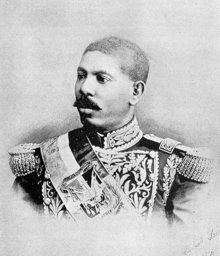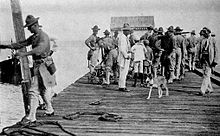The voluntary colony and the Restoration republic

General Gregorio Luperón, Restoration hero and later President of the Republic
Political strife again prevailed in the following years; warlords ruled, military revolts were extremely common, and the nation amassed debt. It was now Báez's turn to act on his plan of annexing the country to the United States, where two successive presidents were supportive.[17][31][35] U.S. President Grant desired a naval base at Samaná and also a place for resettling newly freed Blacks.[36] The treaty, which included U.S. payment of $1.5 million for Dominican debt repayment, was defeated in the United States Senate in 1870[31] on a vote of 28–28, two-thirds being required.[37][38]

Ulises 'Lilís' Heureaux, President of the Republic 1882–84, 1886–99
"Lilís", as the new president was nicknamed, enjoyed a period of popularity. He was, however, "a consummate dissembler", who put the nation deep into debt while using much of the proceeds for his personal use and to maintain his police state. Heureaux became rampantly despotic and unpopular.[39][40] In 1899 he was assassinated. However, the relative calm over which he presided allowed improvement in the Dominican economy. The sugar industry was modernized,[41]:p10 and the country attracted foreign workers and immigrants, both from the Old World and the New.
From 1902 on, short-lived governments were again the norm, with their power usurped by caudillos in parts of the country. Furthermore, the national government was bankrupt and, unable to pay Heureaux's debts, faced the threat of military intervention by France and other European creditor powers.[42]
U.S. interventions and occupation
U.S. President Theodore Roosevelt sought to prevent European intervention, largely to protect the routes to the future Panama Canal, as the canal was already under construction. He made a small military intervention to ward off the European powers, proclaimed his famous Roosevelt Corollary to the Monroe Doctrine, and in 1905 obtained Dominican agreement for U.S. administration of Dominican customs, then the chief source of income for the Dominican government. A 1906 agreement provided for the arrangement to last 50 years. The United States agreed to use part of the customs proceeds to reduce the immense foreign debt of the Dominican Republic, and assumed responsibility for said debt.[17][42]After six years in power, President Ramón Cáceres (who had himself assassinated Heureaux)[39] was assassinated in 1911. The result was several years of great political instability and civil war. U.S. mediation by the William Howard Taft and Woodrow Wilson administrations achieved only a short respite each time. A political deadlock in 1914 was broken after an ultimatum by Wilson telling Dominicans to choose a president or see the U.S. impose one. A provisional president was chosen, and later the same year relatively free elections put former president (1899–1902) Juan Isidro Jimenes Pereyra back in power. In order to achieve a more broadly supported government, Jimenes named opposition individuals to his Cabinet. But this brought no peace and, with his former Secretary of War Desiderio Arias maneuvering to depose him and despite a U.S. offer of military aid against Arias, Jimenes resigned on May 7, 1916.[43]
Wilson thus ordered the U.S. occupation of the Dominican Republic. U.S. Marines landed on May 16, 1916, and had control of the country two months later. The military government established by the U.S., led by Rear Admiral Harry Shepard Knapp, was widely repudiated by Dominicans. Some Cabinet posts had to be filled by U.S. naval officers, as Dominicans refused to serve in the administration. Censorship and limits on public speech were imposed. The guerrilla war against the U.S. forces was met with a vigorous, "often brutal" response.[43]
But the occupation regime, which kept most Dominican laws and institutions, largely pacified the country, revived the economy, reduced the Dominican debt, built a road network that at last interconnected all regions of the country, and created a professional National Guard to replace the warring partisan units.[43]
Opposition to the occupation continued, however, and after World War I it increased in the U.S. as well. There, President Warren G. Harding (1921–23), Wilson's successor, worked to end the occupation, as he had promised to do during his campaign. U.S. government ended in October 1922, and elections were held in March 1924.[43]
The victor was former president (1902–03) Horacio Vásquez Lajara, who had cooperated with the U.S. He was inaugurated on July 13, and the last U.S. forces left in September. Vásquez gave the country six years of good government, in which political and civil rights were respected and the economy grew strongly, in a peaceful atmosphere.[43][44]

Δεν υπάρχουν σχόλια:
Δημοσίευση σχολίου